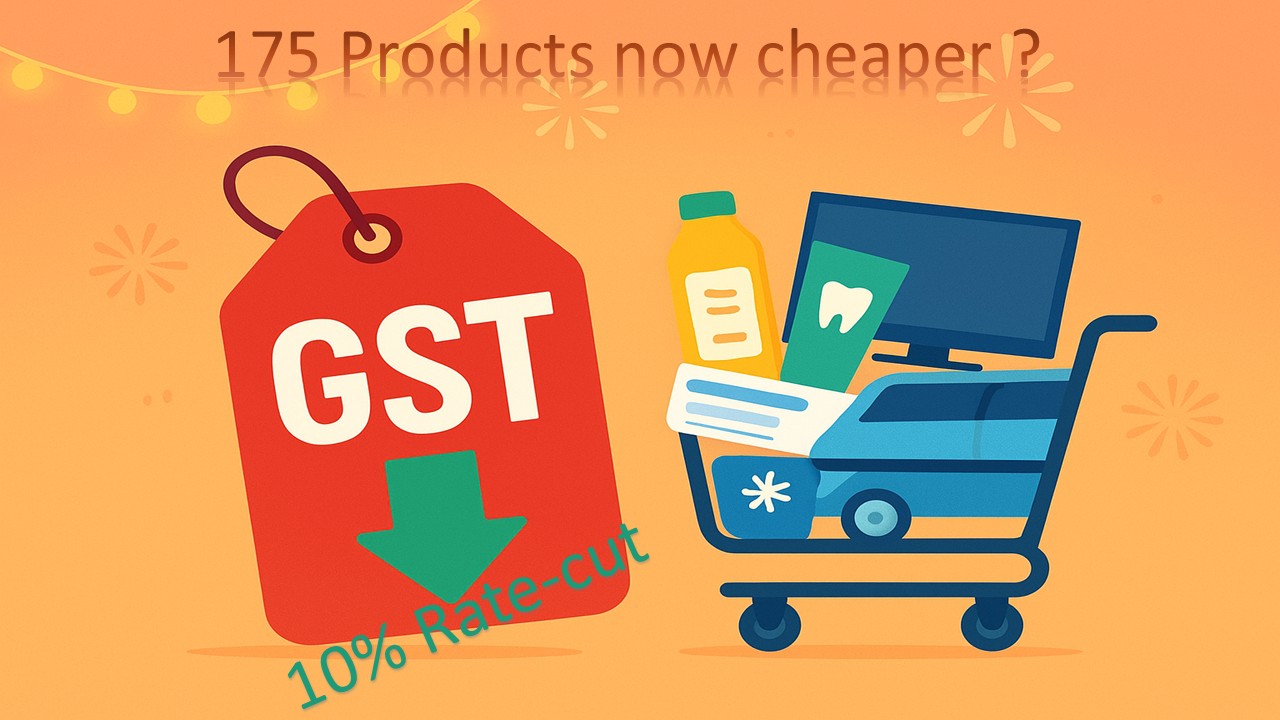
हिंदी में पढ़ने के लिए मेनू बार से हिंदी भाषा चयन करें।
The Indian government is preparing a significant Goods and Services Tax (GST) reform that could bring major relief to consumers and industries. As per reports, GST rates on nearly 175 products — ranging from shampoos and toothpaste to hybrid cars, air conditioners, and televisions — may be reduced by at least 10 percentage points. This move is aimed at boosting demand ahead of the festive season, supporting domestic manufacturing, and easing household expenses.
What Is Being Proposed?
The government plans to restructure GST slabs and bring down tax rates for a wide range of goods. For instance:
- Personal care items like shampoo and toothpaste, talcum powder could move from 18% to 5%.
- Consumer durables like Acs, dishwashers, TVs and other appliances may see a cut from 28% to 18%.
- Small petrol hybrid cars could also benefit from a GST reduction from 28% to 18%.
- Fertilizers and some farming equipment may also see reductions.
Why Is the Cut Being Considered?
- Boosting Domestic Demand: Lower prices during the festive season (like Diwali) can drive higher sales.
- Supporting Industries: Automobile, FMCG, and consumer electronics companies could see stronger demand and higher production.
- Relief From Inflation: Reduced tax will make essentials and household products cheaper, bringing relief to families.
Who Will Benefit the Most?
- Consumers: Lower prices on daily essentials and big-ticket items like ACs and TVs.
- Automobile Companies: Brands offering hybrid cars (Toyota, Maruti Suzuki) may see higher sales volumes.
- Retailers & Brands: Cheaper products mean faster inventory turnover and festive-season demand surge.
Impact on Government and States’ Revenue
While tax cuts will help consumers, they could also mean short-term revenue losses for both the Centre and states. Since GST is a shared tax, the proposal will need approval from the GST Council, where state governments may raise concerns over potential revenue gaps.
Market and Stock Market Impact
News of possible GST cuts has already created a positive buzz in the stock market. Shares of auto, electronics, and FMCG companies may gain as investors expect higher demand. However, final Council approval will decide the real outcome.
How Much Will Consumers Actually Save?
The real savings will depend on how much of the tax cut companies pass on to buyers. For example:
- If an AC worth ₹40,000 currently attracts 28% GST, reducing it to 18% could mean a saving of several thousand rupees.
- Hybrid car buyers may save anywhere from thousands to lakhs depending on the model, once the GST and cess adjustments are finalized.
Timeline and Implementation
The proposal is expected to be taken up in upcoming GST Council meetings. Only after the Council’s final approval will new rates be notified. This means consumers may have to wait a little longer before seeing the reduced prices in the market.
Risks and Challenges
- Revenue Loss for States: States may push back if the cuts hurt their income.
- Uneven Impact: Benefits will be concentrated in selected sectors like auto, FMCG, and durables.
- Pass-Through Uncertainty: Companies may not always pass the full tax cut to customers.
Outcome
The proposed GST rate cut could be a game-changer for consumers and businesses alike. If approved, everyday essentials and big-ticket items will become more affordable, boosting sales during the festive season. However, the real impact depends on how much benefit is passed on to buyers and how states respond to potential revenue loss.
Sources: Reuters report on India’s planned GST cuts, and PIB release from PM Modi’s Independence Day speech on next-generation GST reforms.




































































